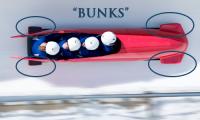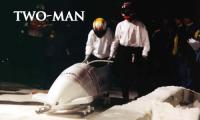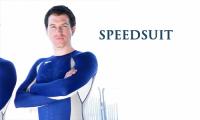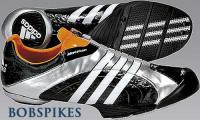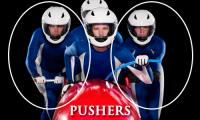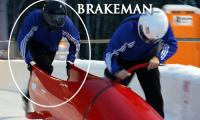Bobsled 101: Glossary, Photos, Videos & More
 Over the years I have been asked just about every question you can think of when it comes to bobsled. From "What do they make the ice out of?" to "What if you put flour on the sled's body to help with aerodynamics?" (true story) so I wanted to compile a brief summary of some key terms and components of my beloved sport.
Over the years I have been asked just about every question you can think of when it comes to bobsled. From "What do they make the ice out of?" to "What if you put flour on the sled's body to help with aerodynamics?" (true story) so I wanted to compile a brief summary of some key terms and components of my beloved sport.
These are very basic definitions and descriptions designed for the general public, so my colleagues in the sport may find this page redundant. But for those of you who want to learn more about the world's BEST winter sport, read on!
THE SLED:
- Bunk: The four wings on the sides of the bobsled (two in front, two in back) that keep the body of the bobsled from hitting the walls. Also, in Four-Man bobsled the two side pushers load into the sled by stepping on the Bunks.
- Brakes: The Harrow-type implements that dig into the ice once a bobsled crosses the finish line. Controlled by the team’s Brakeman. The brake handles are located on the brakeman’s sides in a four-man sled or to their front in a two-man sled.
- Four-man Bobsled: A Four-Man bobsled measures 3.8 meters (about 12 feet) in length and weighs no more than 630 kilograms (1,389 pounds) with crew. A Four-Man bobsled crew consists of the Pilot, a Brakeman and two Side Pushers. 4-man sleds can often reach slightly higher speeds on the track than Two-Man bobsleds.
- Two-man Bobsled: A 2-man bobsled measures 2.7 meters (about 8 feet) in length and weighs no more than 390 kilograms (860 pounds) with crew. Crews of a 2-man are made up of the pilot, or driver, and a brakeman.
EQUIPMENT:
- Bobspikes: The special sprint shoes we use in bobsled that include hundreds of sharp steel spikes on the soles of the shoes which allow us to push on the ice. Those spikes cannot be thicker than one mm or longer than four mm.
- Burn Suit: (also burn vest) The special friction-dissipating shirt worn underneath speedsuits to protect athletes from ice burns in the case of a crash.
- Helmets: Bobsled helmets need a certified EEC safety rating such as OKM or DOT and protect our heads from the serious injuries that can result in memory loss, reduced physical mobility, or perhaps even death.
- Runners: Four highly polished steel sliders on which the sled rides. It is prohibited to heat the runners or treat them with any gaseous, liquid or solid substances in order to improve their sliding capabilities.
- Scabbards: Protective covers that go over the bobsled’s runners which allow teams to move their sleds around with damaging their polished surfaces.
- Shims: Thin sheets of metal placed between the sled’s Runner and Shoe to reduce chatter and help with alignment.
- Speedsuit: Those awesome superhero spandex suits we wear for competitions.
ATHLETES:
Brakeman: Athlete who sits in the back of the sled in Two-Man and Four-Man bobsled.
Driver: see Pilot
Pilot: The athlete who drives the sled by use of steering ropes and the steering system which controls the front two Runners. The Pilot sits in front in both two-man and four-man bobsled.
Pushers: In the four-man sled, two additional athletes help push the sled and then sit in the sled between the pilot and brakeman.
THE TRACK:
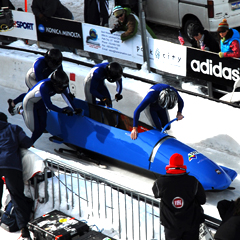 Braking Stretch: The section of the track just beyond the Finish Line where teams use their brakes to decelerate. It’s the part on TV where all the ice is spraying out to the side.
Braking Stretch: The section of the track just beyond the Finish Line where teams use their brakes to decelerate. It’s the part on TV where all the ice is spraying out to the side.
Buzzer: An audible noise that lets the team know the track is clear for them.
Control Tower: Just like at an airport, the track’s Control Tower monitors track clearance, the timing system, the video system and more. They’re the bosses.
Cornering: When a bobsled team heads through one of the track’s curves.
Course: See Track
Finish Area: The area at the bottom of a track where teams remove their bobsleds from the track and place the sled into its Scabbards.
Finish Clock: The timing scoreboard that sits near the finish area.
Kreisel: A turn on a bobsled track that curves back on itself and is between 270 and 320 degrees around the circumference.
Labyrinth: A portion of the track that consists of a three-turn combination.
Line: The best or most efficient route around a track. A "high line" takes a sled closer to the top of a turn while a "low line" takes a sled closer to the bottom, or belly, of a turn.
Lip: A reinforced safety barrier that sits on the top edge of turns and prevents sled from flying off the track. Hit these and you’ll bounce off back down the turn.
Omega: a large turn that looks like the Greek letter Omega or a ‘W’.
Push Block: A wooden block frozen into the ice on the Start Ramp that the team uses to push off of during the Push Start.
Start Area: The top area of the track where teams prepare and queue their sleds.
Start Clock: a countdown clock off to the left of the Start Ramp that contains a green light and a buzzer to let the athletes know when the track is cleared for their run. Bobsled teams have 60 seconds from this point to break the first timing point.
Start Ramp: The Start Ramp on a track is the initial decline that bobsled teams push down and load into their sleds for their Run down the course.
Sturz: (also 10-81) German word for crash.
Track Crew: The talented professionals who keep the track running smoothly. They clean and shape the ice in the curves and monitor the overall conditions of the course.
THE RACES:
Disqualification: (also DQ’d) When an athlete or team is found to have broken one of the rules he, she or they are Disqualified from the race.
Heat: A heat in bobsled consists of one rotation of the race order.
Loading: The portion of the Push Start where the athletes load into their seats in the sled.
Officials: A team of dedicated professionals that help make sure everyone is adhering to the rules of the game from the start of the competition to the end.
Push Start: The portion of a run where the team pushes the bobsled down the Start Ramp and loads in. This is all about speed and power and the race can be won or lost with a Push Start.
Run: (also decent) A run consists of a full trip down the course for a team.
Timing Points: The Timing Points on a track are locations where sensors have been embedded into the course’s Short Walls so as to measure a team’s speed and time spent on their current Run.
ORGANIZATIONS:
 FIBT: Fédération Internationale de Bobsleigh et de Tobogganing, the international governing body for bobsled and skeleton.
FIBT: Fédération Internationale de Bobsleigh et de Tobogganing, the international governing body for bobsled and skeleton.
IOC: The International Olympic Committee is international, non-governmental, non-profit organisation based in Lausanne, Switzerland which is the supreme authority of the worldwide Olympic movement.
IPC: The International Paralympic Committee is an international non-profit organisation and the global governing body for the Paralympic Movement.
USOC: Founded in 1894 and headquartered in Colorado Springs, Colo., the United States Olympic Committee serves as both the National Olympic Committee and National Paralympic Committee for the United States.
USBSF: The United States Bobsled and Skeleton Federation is the national governing body for bobsled and skeleton for the U.S.


